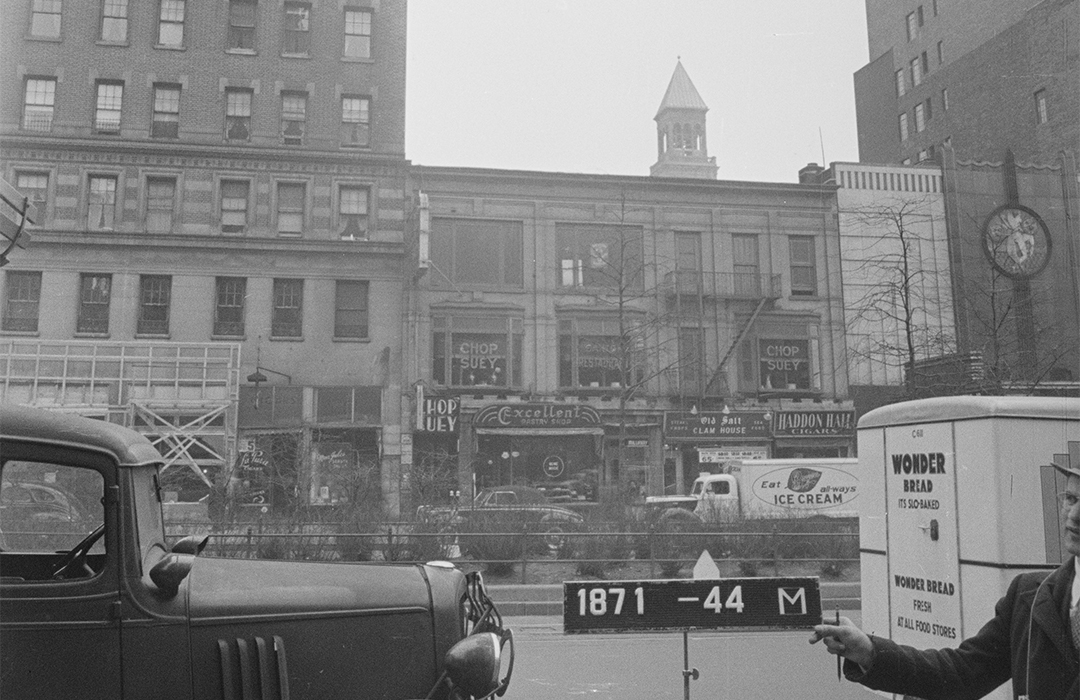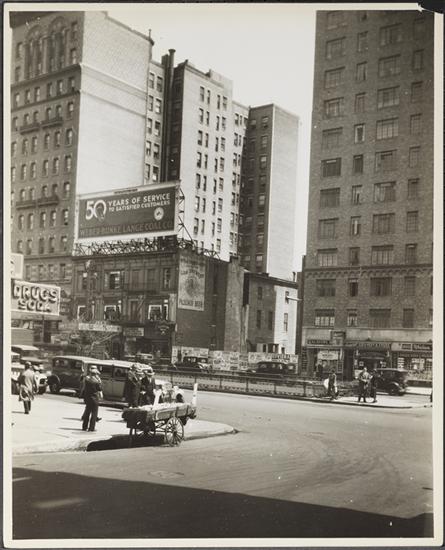
2628-2630 Broadway
by Tom Miller
In 1897 the Metropolitan Impt. Company hired architect Alexander Fowler to design two three-story multi-use buildings on mid-block on the east side of the Boulevard (later Broadway) between 99th and 100th Streets. The nearly matching structures were designed in a commercial take on Renaissance Revival. The wider, northern building had two slightly projecting show windows at the second floor and two large windows at the third. The southern building had metal-framed show window, identical to those in the structure next door, and a narrow window at the second floor, and three openings on the third.
The buildings filled with a surprising number of tenants, the businesses of which were greatly varied. Among the occupants of 2630 Broadway at the turn of the century was David Cantor’s pool and billiard hall. Owners of businesses like saloons and pool halls had to be prepared for sometimes unruly customers, and late on the night of January 6, 1901, David Cantor encountered a serious problem.
According to him, just as he was preparing to close at midnight, “a crowd of young men came in and insisted on playing pool.” He told them the hall was closed, but they pushed forward, determined to play. When they began to take pool cues down from the wall rack, a fight erupted between Cantor and the men. When 29-year-old George O’Hara attempted to strike Cantor with a cue, Cantor shot him in the abdomen. The New-York Tribune reported, “The injured man was taken to the J. Hood Wright Hospital.” Cantor, who pleaded self-defense, was arrested. It seems that before the police could arrive, the gang of O’Hara’s friends exacted revenge. The Morning Telegraph said simply, “Cantor was badly beaten.”
Somewhat surprisingly, the city leased space in both buildings for the Twelfth District Municipal Court that year. While the move was deemed temporary “until suitable quarters may be found,” according to The City Record, the courtroom and court offices would remain through 1906.
When 29-year-old George O’Hara attempted to strike Cantor with a cue, Cantor shot him in the abdomen.
The broad range of tenants was reflected in the Metropolitan Motorcycle shop occupying a ground floor store by 1906, S. Wechsler’s men’s clothing factory in an upstairs space of 2628, and attorney Max Rechnitzer’s office in that building at the time.
In 1909 Professor W. S. Reeves opened his Conservatory of Dancing, Music and Singing in 2830 Broadway. Along with music and singing, his advertisement offered lessons in “fancy, society and ballroom dancing.” In 1912 Reeves was the center of social controversy over a dance he had devised a year earlier, the Chicken Reel. He explained to a reporter from The Castilian in February 1912, “I danced the chicken reel for a club dance in Newport last summer, when I was asked to get up something new.” The article explained:
In the ‘chicken reel,’ the partners hold hands and take four steps forward, flapping the outer arms like the wings of a chicken and rising on the toes at the same time. Then both stop and scratch like a chicken four times with the right foot facing each other.
Society was not amused. The Castilian reported, “the ‘Chicken Reel,’ the last word in the dance zoo, may be all right in Newport, but they don’t go among real society folk in New York.” The article said the dance was “barred by society.”
By the time of Reeves’s upsetting polite society, the Christensen School of Piano Playing was also in 2630 Broadway. An advertisement in The Brooklyn Daily Eagle in February 1911 promised, “Ragtime Piano Playing guaranteed in 10 to 20 lessons.” Occupying a double store at the time was Doré Atelier, which sold “ladies tailored garments and fancy costumes.”
Upper floor offices in 1911 and 1912 were occupied by the Colonial Employment Agency, civil engineer John H. Myers, and printer Stephen E. Masten, who handled small jobs like calling and business cards. Much more unexpected was Glover’s Gymnasium, which occupied space in 2630 Broadway in 1912. An advertisement in the Columbia Spectator that year noted it was for “Ladies and Gentlemen” and offered, “Boxing Instructions, Physical Culture, Handball Court, Weight Reducing a Specialty.”
By 1913 the United Schools operated from 2630 Broadway (very likely an offshoot of the Christensen School of Piano Playing). It offered mail-order lessons for $2. An advertisement read, “Learn Ragtime (professional style), vaudeville, Motion Picture Playing, with copyrighted self-instruction book.”
The Reeves dancing academy was supplanted by the Salon de Danse in 1913, run by George Hepburn Wilson. He and his staff gave only private instruction in all the popular modern dances. The problem for Wilson was that he had no license. He was arrested on December 29, 1913, on charges of “teaching dancing and running a dance hall without a license.” He posted bail and was scheduled to appear before a judge on February 26, 1914. The following day, The New York Press headlined an article, “Tango Teacher Jumps Bail,” and reported that Wilson, “a tango teacher, of No. 2630 Broadway,” failed to appear and his $500 bail (a significant $15,000 in 2023) was forfeited.
In 1919 the second floor of the buildings was combined internally for the Canton Restaurant. It described itself as “Chop Suey and Tea Parlor” in an advertisement that year.
An American restaurant, the Cecil, occupied a ground floor space in 2630 by 1926. It offered a “special club breakfast,” while the “Special Table D’Hote Luncheon” cost 65 cents, and the “Special Table D’Hote Dinner” was $1.00 (about $16.50 for dinner by today’s conversion). The restaurant had a special employee that year in 14-year-old Ralph Rose, whose job was to sell candies.
The New York Sun described him on April 20 that year as “a slender, dark eyed youth still in knickerbockers.” He was also a prodigy. An Oklahoman, Rose had won the Juilliard violin scholarship at the age of 13. The article said that a few months earlier he “astonished the congregation of Temple Emanu-El with his playing. He is the boy who recently played two of his own compositions, ‘Oriental’ and ‘Dance of the Gnomes,’ before the Drama Study Club at the Hotel Astor.” The teenaged candy seller at the Cecil Restaurant would go on to become the first conductor of the Oklahoma Federal Symphony Orchestra at the age of just 27.
The New York Press headlined an article, “Tango Teacher Jumps Bail”
In 1933 two of the ground floor spaces were joined for the Excellent Restaurant and Cafeteria. It had not been open especially long when a tragic incident occurred. On December 12, 1934, 25-year-old Harry Geranis, a contractor, and a friend, Arestopemor Bauyukan, stopped in for dinner just before 11:00. While they ate, Geranis complained of severe chest pains. Not wanting to take any chances, Bauyukan rushed him out of the restaurant and into a taxicab headed for St. Luke’s Hospital. When they arrived, as reported by The New York Sun, Geranis was dead.
The Excellent Restaurant was still operating in the space in 1941 when another restaurant, the Old Salt Clam House occupied another ground floor store space in 2628. As suggested by the name, it specialized in seafood “cooked to order.”
One the second floor, where The Canton once served Chinese food, the Eastern Garden restaurant followed suit, opening in March 1959. Craig Claiborne, food critic of The New York Times mentioned, “Although the décor of the new establishment is routine, the cuisine is generally excellent and reasonably priced.”
A renovation completed in 1983 resulted in both the ground floor and the second floor of both buildings being combined internally for two separate restaurants. The first floor became home to a Wendy’s fast food branch, and the second floor to Bahama Mama, described by The New York Times’s Bryan Miller on April 24, 1987 as “a funky Caribbean restaurant…a low-budget, bibulous hangout splashed with island colors.”
Then, in 1995, the Home Grown Theatre Company opened here. Its first production was Oh! Caulcutta! In November that year.
At the time of that opening, the 98-year-old building had only 10 years left. It was demolished in 2005 to make way for a high-rise tower.
Tom Miller is a social historian and blogger at daytoninmanhattan.blogspot.com
BUILDING DATABASE
Keep Exploring
Be a part of history!
Think Local First to support the business at 2628-2630 Broadway:



